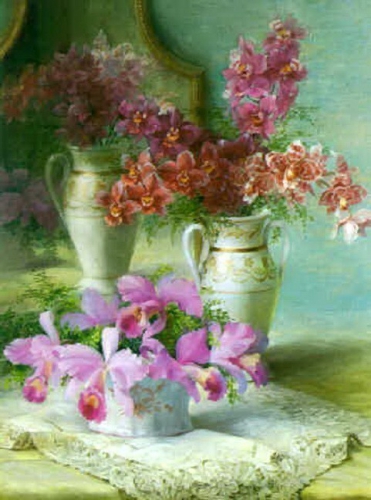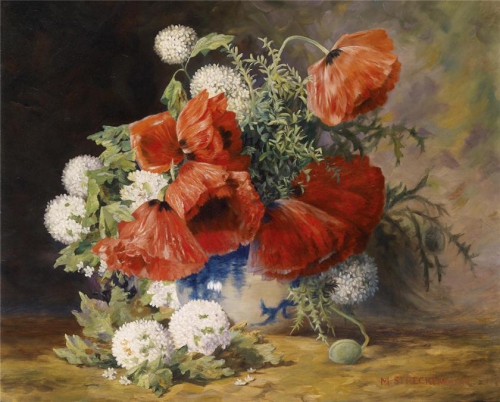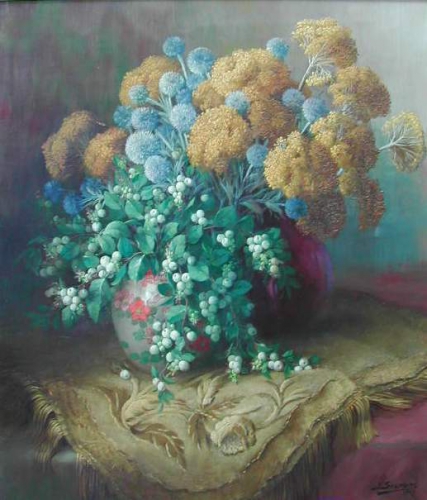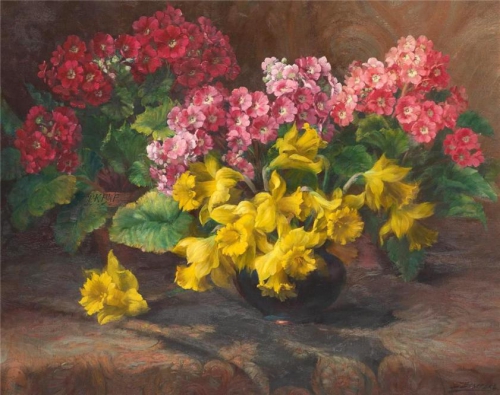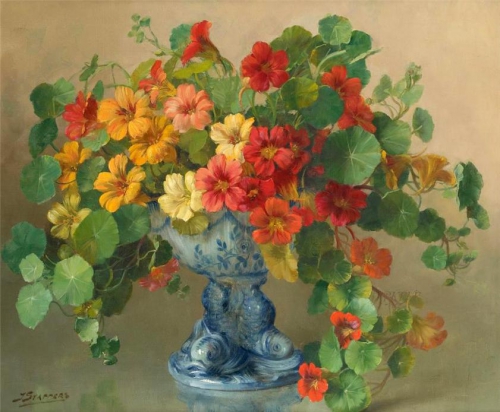31/12/2014
I leave in your eyes, as the mystery ... ~ Artist Rahaf Dk Albab
Rahaf Albab Dk - designer, artist and illustrator living and working in Damascus, Syria ..
I leave in your eyes, like a secret,
Do not be shy and do not contradict.
Never look at them will not get tired -
Live there and love shines.
Look and you in mine, do not be afraid.
As a teacher in a student notebook.
But I do not know happiness if they have more
Or fear - happiness lose.
Michael Plyatskovskim
Lovely melody! Include yourself!
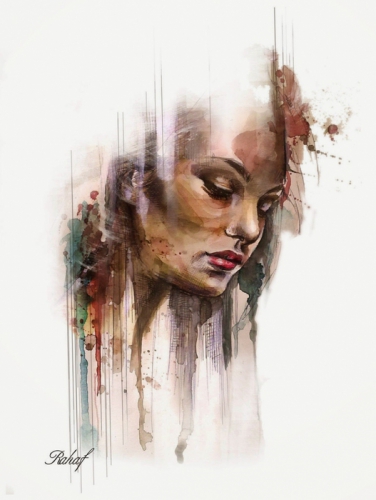
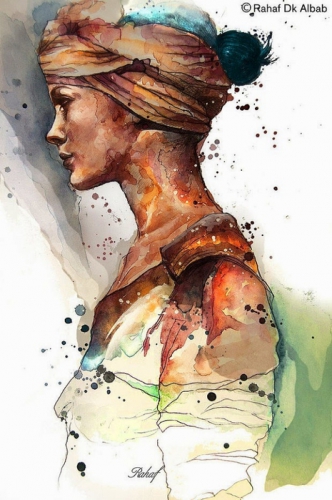
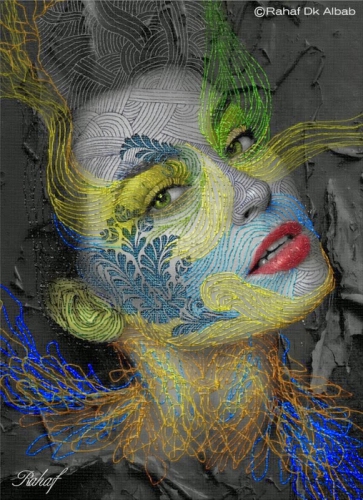
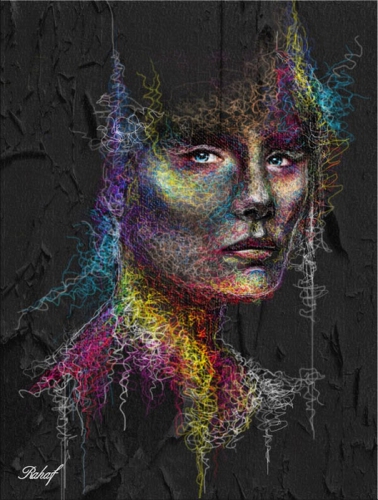
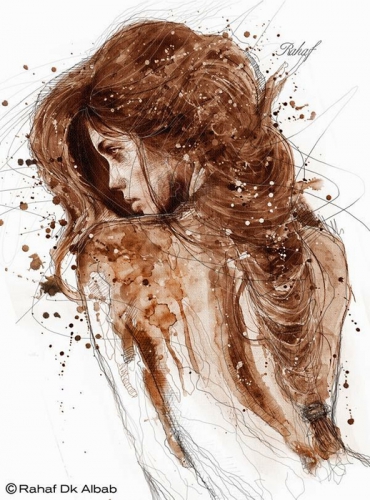
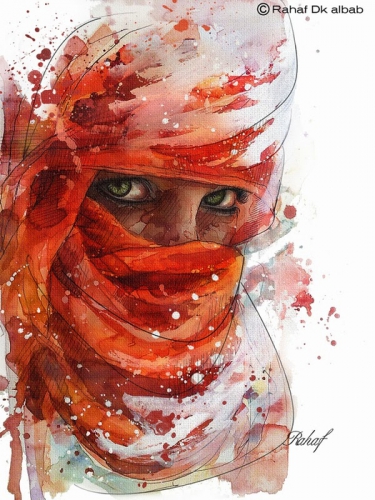
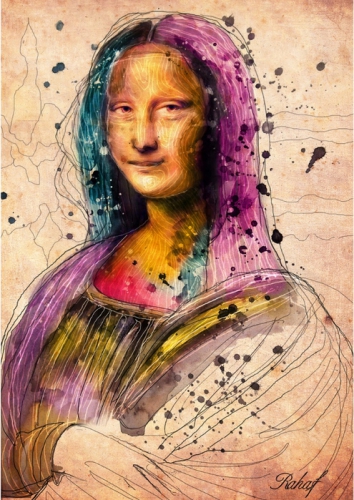
03:29 | Lien permanent | Commentaires (0)
29/12/2014
Julien Stappers (1875-1960). Still Life
09:50 | Lien permanent | Commentaires (0)
27/12/2014
Still life in Russia. The beginning of the twentieth century
Still life as an independent genre of painting appeared in Russia at the beginning of the XVIII century. The idea of it was originally associated with the image of the gifts of the earth and the sea, diverse world of things surrounding man. Until the end of the 19th century still life, in contrast to the portrait and historical paintings, seen as a "lower" genre. It existed mainly as an academic setting and allows only a limited understanding of how the painting of flowers and fruit.
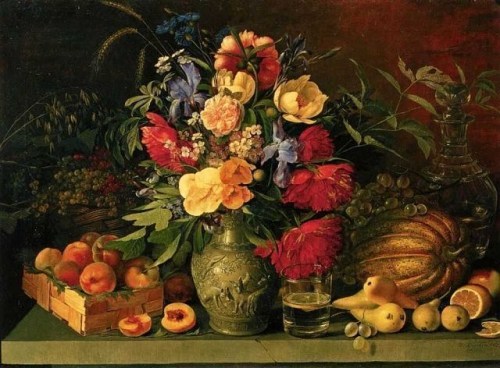
Ivan Khrutsky "Flowers and Fruit" in 1839
The beginning of the twentieth century saw the flowering of Russian painting still life, gained its first equality among other genres. The desire to empower artists visual language was accompanied by an active search in the field of color, form, composition. All this is especially evident in the still life. Enriched with new themes, images and artistic techniques, Russian still life developed extraordinarily fast: for fifteen years he goes from impressionism to abstract shapes.
Then, in Russia there were many art associations.
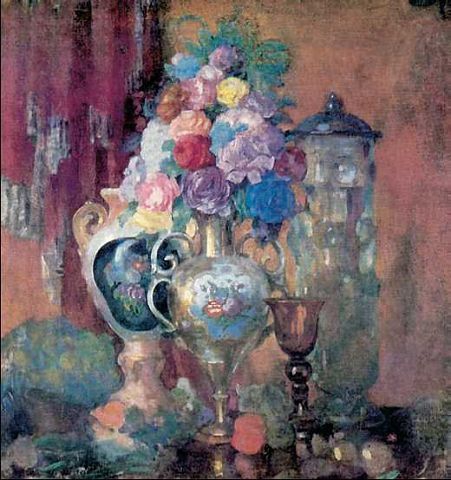
Nicholas Sapunoff "Flowers and vase on a pink background," 1910
Bright artist, a master of theatrical compositions and exotic still lifes, N. Sapunoff had a very peculiar coloristic talent. At the time of writing still life "Flowers and vase on a pink background" Nicholas Sapunoff was a member of the Symbolists "Blue Rose". Poetics of symbolism attracted artists to the romantic okultnym topics.
Blok singled out his work in quest of color rhythm, color music, color drama that would meet those drama productions, which he painted scenery.
Prone to bohemian artist once sailed with the company in a boat on the Gulf of Finland, and was drowned at the age of 32 years.
Pyotr Konchalovsky was a member of the association "Jack of Diamonds". For this association is characterized by the search for new solutions zhivopisno- plastic, deformation and dismemberment shape, texture painting, revealing the shape and volume of the color, the pursuit of sensual painting, material and colorful side of life. Ideological origins - the so-called "Russian sezannizm" Russian folk art (splint, icon, tile, painting, shopping signs).
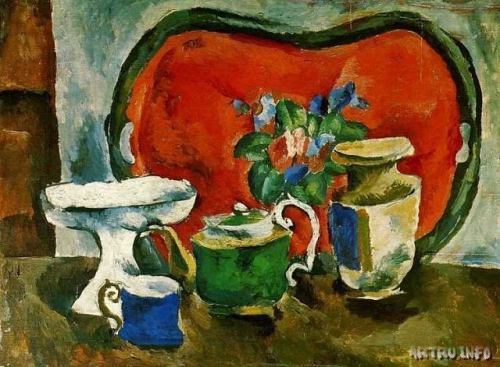
Konchalovsky "red tray" 1913
Enlarge, roughened, but do every thing dense and strong - that's the task of the young Konchalovsky in his many still lifes, which often appears by chance the same tray market as a kind of tuning fork, painting sets the desired level of color voltage. The color here conveys not only sketchy coloring as the very form and weight, flesh material things.
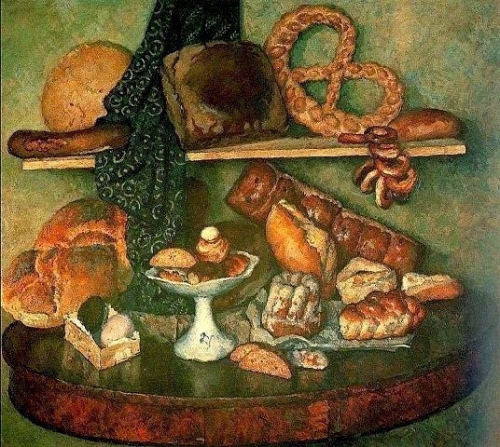
Ilya Mashkov "victuals Moscow"
Notoriety was accompanied by a young Ilya Mashkov - Gambling and adventurous nuggets scored life experience "in people" (working in the shops from the merchants) who "universities" in European museums, but expelled in 1909 from the walls MUZHVZ (Mosk. School of Painting, Sculpture and Architecture). However, still learning, Mashkov with great success taught himself - his studio (1904-17; in 1925 transformed into a central studio AHRR) was the most expensive and at the same time the most visited in Moscow.
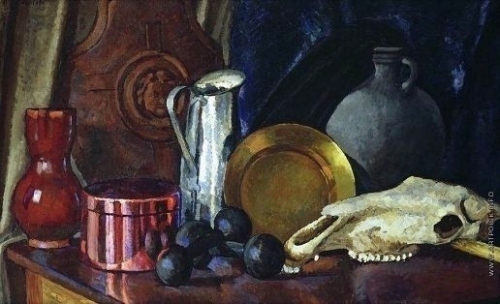
Ilya Mashkov "Still life with a horse skull", 1914
Impressed the audience and critics "barbaric" head of his paintings at the exhibitions "Golden Fleece" and "Salon Izdebsky" (1909-10), Mashkov has found its place among artists, formed the society "Jack of Diamonds" (Pyotr Konchalovsky, A. . Lentulov et al.). "Jacks" claimed the material world and "low" of the object; generosity and major Mashkovskii palette abundantly his still life productions were in tune with the program association.
In an effort to bring back the art of "down to earth" artists of this circle focused on the "craft" - a street sign, a tray, a splint. Mashkov is native craft was a child, and primitivism of his still lifes and portraits - the most simple and genuine.
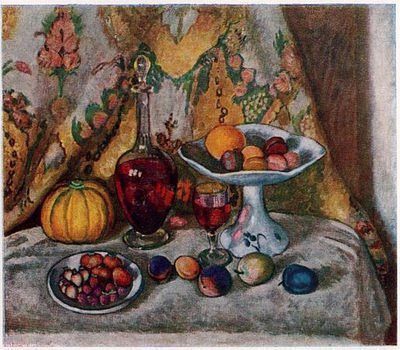
Ilya Mashkov "Still Life with Fruit"
Painter in love "in a bright flesh and blood of things." This life-affirming, realistic, optimistic installation was could not be more suited to the new challenges of art. A clear view of the world view of the working man, rejoicing and celebrating the work itself of its results, is characteristic of the artist in the years after the revolution. Mashkov have its own special understanding of the relationship of painting and object space, and the pathos of it - in the adoption of healthy reality of the object through the strengthening of its plastic and color characteristics.
Heightened attention to the intrinsic value of items allowed the painter found in simple, familiar things new expressive possibilities.
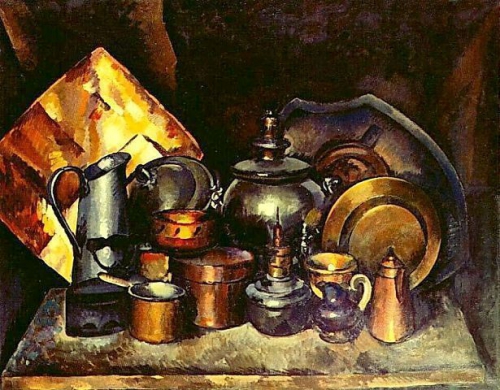
Ilya Mashkov "Copper cookware"
In "Still Life with a samovar (Copper cookware)" (1919) kitchen utensils - coffee pot, milk jug, cups, plates, iron, trays, - rallied together and displacing space on the periphery of the canvas, like a small, but its strong unity and confidence army. Restrained, almost monochrome color scheme highlights the shape of objects beamed, sends them soft but strong luster. Every thing appears in its bright individual look, but they all share some almost "ideological" community - belonging to the same "class" material - copper. It is the apotheosis of beauty modest metal and it sounds ringing, solemn, powerful. Sovereign, are weighty copper items, and the audience, conquered them coming from a low-key force forgets purely domestic appointing them.
Still Life Petrov-Vodkin unpretentious recruitment of subjects and bear signs of severe era in which they were created. In this sense, has become a classic still life with a picture of a skinny herring, a piece of bread and two potatoes - meager rations hungry time.
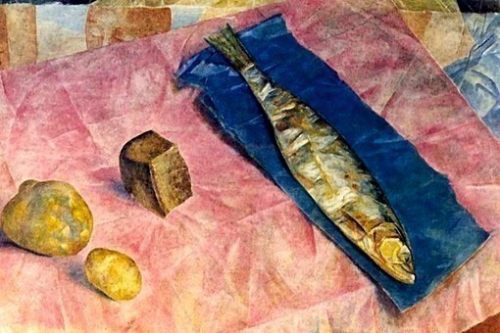
Kuzma Petrov-Vodkin "Herring", 1918
The artist likes to introduce them in the mirror, glass or just some shiny objects (samovar, nickel-plated kettle), to enable him to analyze complex play of reflections, refractions of the incident and reflected in the inner faces of the beams of light. In these studies, in the spirit of Vrubel Petrov-Vodkin replaces the passion of his brilliant predecessor methodically-persistent desire for knowledge of the subject in all its aspects.

Kuzma Petrov-Vodkin "Still Life with ink", 1918
Spread out and placed on the table the artist sees things from above, so that the location of their subjects accurate fixation and they can be seen "at a glance"; polished granite teapot or glass table top double image, allowing you to look at it with an invisible hand artist. Thus, Petrov-Vodkin overcomes monocular point of view, the apparent lack of it and do not reflect the true knowledge about the subject that you can walk around, eventually getting total and a better understanding of it.
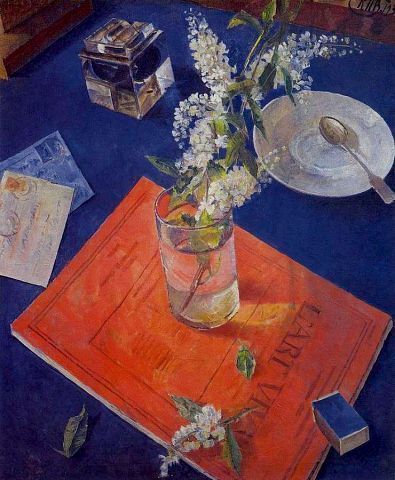
Kuzma Petrov-Vodkin "Bird cherry in a glass" 1932
Most amazing of all still lifes Petrov-Vodkin is that keen, sometimes detailed analysis of objects and a strict, almost experimental compositional structure of the canvas or in any way deprive them of the immediacy of artistic perception of nature, not to mention the richness and subtlety of color. Special clarity in which subjects as would be named at a time and do not obstruct each other, creates an almost physical sense of joy in the contemplation of these still lifes, such as simple and such, in fact, difficult as far from easy and definitely not all art Petrova -Vodkina.
Alexander Kuprin, becoming a member of the "Jack of Diamonds", he shared a common passion for Cézanne, but his interpretation sezannistskie gain an enhanced composition of aspect, shape - prickliness, color - contrast and tension.
Understanding the world as a great still life, as a combination of tangible and material colorful textures, it does not refer to radical forms of avant-garde - stopped on the threshold of Cubism - neither cheap popular-primitive folklore.
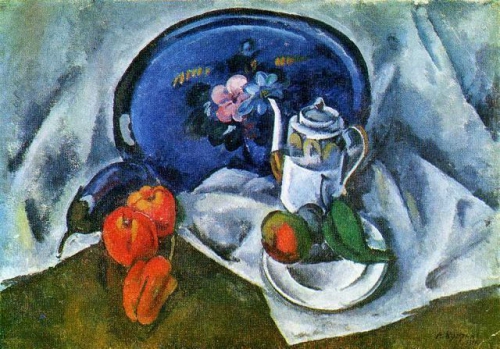
A.Kuprin "Still life with blue tray" 1914
In the works of his early period is dominated by intense colorful contrasts, nature is perceived as it were, tangibly, subject and at the same time quite aloof.
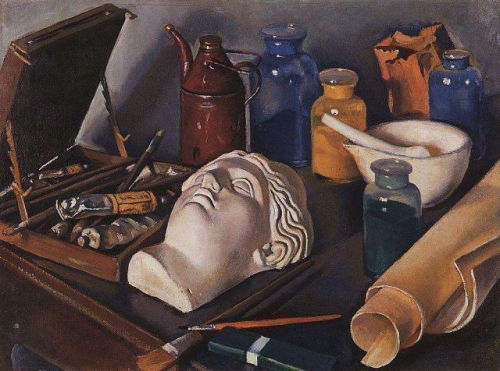
Zinaida Serebryakova "Still Life with Attributes of the Arts"
This work Serebrya has a traditional song for the artist. As is customary in the works with a similar name, there is shown an ancient mask, there is a box of paints, paper roll, scroll-like, in the background is a glass bottle with powder pigments for paints and bright ceramic mortar. Still Life on a "production theme" often found in the works of artists.
In 1913 .P.Konchalovsky painted "dry ink", which is clearly visible to the artist's interest in the combination of bright pigments: orange with cobalt, with a red ocher.
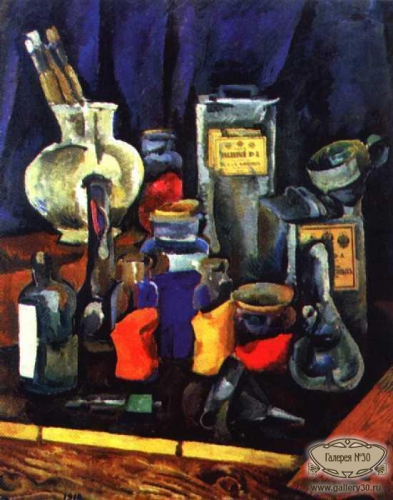
P.Konchalovsky "dry ink" 1913
The canvas is made in the rough, a simplified manner. Painting Serebrya softer, tactfully. In the books in their hands, covered in paint, sheets of drawing paper left on the table, lives warm touch hands of the craftsman, trembling love, keen interest, attachment to the same reasonable and assistants of his labor. And maybe that's the point: in the humanity of the objective world, the visible in his relations with people - all fully reveal the interpretation and evaluation that Zinaida gives reality. It is connected with the world of objects deep inside a community, things serve it as good old servants, well-known in their constant and useful qualities. World Serebrya revealed to us full of smooth, clear, warm light and harmony.
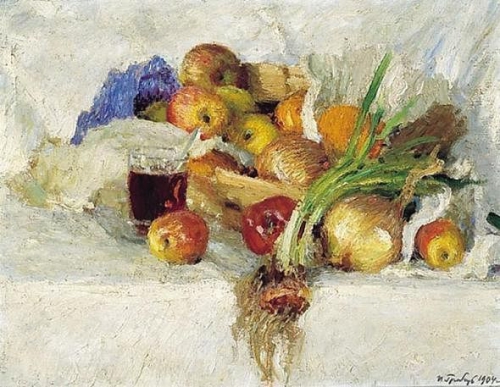
Igor Grabar "Still Life", 1904
Creativity Grabar - is something other than impressionism. The flowering of creativity Grabar preceded by long years of study and a wide variety of experiments. Of course, this does not invalidate the art Grabar no national character, nor the independence and originality, but spurred him in his quest to go beyond Impressionism, and seek to develop a new system of painting.
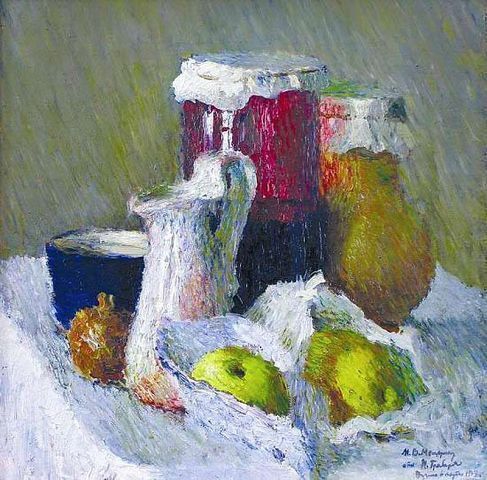
Igor Grabar "jars of jam," 1904
The artist himself considered his still lifes of the 1900s were influenced by impressionism. "Lilac and me-nots," he defined as "a thoroughbred Impressionism".
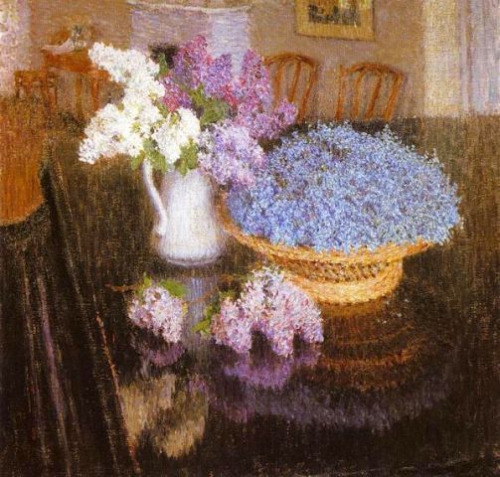
Igor Grabar "Lilac and forget-me"
It was then Grabar fascinated by the beautiful Claude Monet. "Chrysanthemum" in this regard is extremely typical. Color analysis vibrating svetovozdshnoy environment close to some quest French painters of this trend.
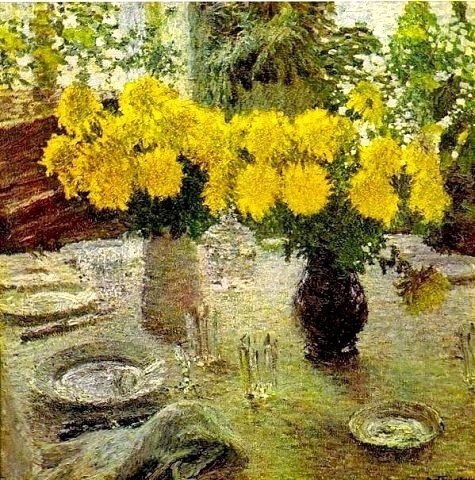
Igor Grabar "Chrysanthemums"
The artist seeks a way out in submission of forms and colors certain decorative rhythm. Very soon it will overcome the known limitations of the method is impressionistic in Grabar consistent. Still life painter puts the purpose of the special analysis of color, shape, material object. Still Life Grabar marked diversity and complexity of the task, the search for new artistic techniques. This is no accident. Everyone here talks about the proximity of a new stage in the development of Russian still life. In an atmosphere of struggle for new art forms, which permeated the painting of the 1900s, still life to become one of the leading genres arena creative experimentation.
In 30-40 years of the twentieth century, the development of the still life to a halt, but since the mid 50s this genre is experiencing a new rise of the Soviet painting and since that time finally and firmly stands on a par with other genres.
04:25 | Lien permanent | Commentaires (0)
